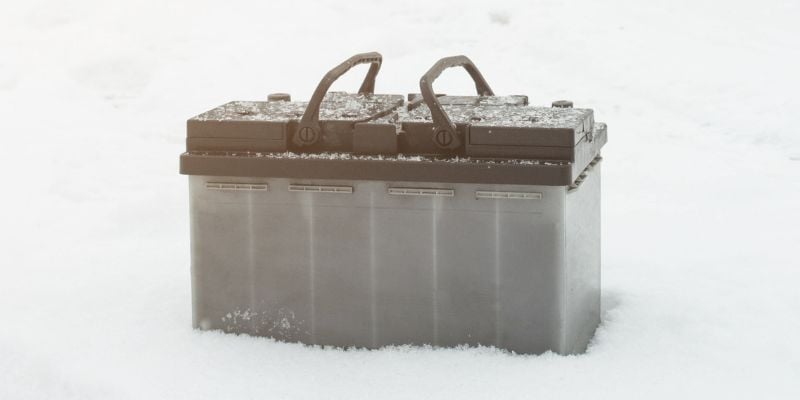First developed for safe use in planes and submarines, absorbent gel mat (AGM) batteries’ near-zero maintenance and reliability save money – and keep your operations or free time activities running smoothly.
In this blog, you’ll discover how to pick longer-lasting batteries – and:
- How AGM batteries work
- How many years do AGM batteries typically last?
- Proven tips to improve longevity
- Battery selection basics
- Avoid this common sizing mistake
- Maximize lifespan with 7+ installation and usage strategies
How do AGM batteries work?
AGM batteries store chemical energy in recyclable lead “plates.” Plates are mesh grids with energy-storing material pasted into the holes.
The plates are wrapped in fiberglass mats that absorb battery acid.
When you use AGM batteries, hydrogen and oxygen recombine inside the battery… so you never have to water the batteries.
Benefits of AGM batteries:
Near-zero maintenance
Because of their sealed design, AGM batteries are largely hands-off and require zero watering.
Since AGM battery plates are wrapped and compressed (more about that in a minute), the up-front manufacturing cost is higher.
However, near-zero maintenance and long-term reliability mean that you'll often improve your ROI compared to flooded lead-acid (FLA) batteries. And for people with less time or resources for maintenance, AGM batteries may last longer just because they don’t require as many maintenance cycles.
Of course, even “maintenance-free” batteries like AGM and Lithium-ion (LI) still require occasional inspection, especially in extreme operating conditions.
Lower lifetime cost and higher value
AGM batteries provide enhanced convenience, durability, and safety.
Plus, they’re about half the cost of lithium-ion (LI) batteries.
The lower cost of AGM batteries is due to:
- Use of primarily recycled/recyclable materials
- Lower material costs
- No complicated internal computers needed for baseline safety.
Faster charging
Because of their design and decreased internal resistance, AGM batteries absorb current faster than FLA batteries – and can deliver higher current than LI batteries.
Faster charging is most important for applications where batteries are subject to rapid discharge in a multi-shift operation and recharged with opportunity or rapid charging systems, such as in commuter electric vehicles (EVs), opportunity charging at warehouses, and renewable energy installations.
And high current delivery is critical because many motors require additional energy while starting up.
Safe
AGM batteries are leak-proof because they’re sealed and their electrolyte is fully absorbed and immobilized by glass mat separators.
And they aren’t vulnerable to thermal runaway, making AGM a lower-risk choice. In contrast, LI batteries can have a higher risk of fires and explosions, largely because of greater energy density.
More sustainable
AGM batteries are more recycled than an aluminum can – 99% recycled –, according to the U.S. EPA (Source: U.S. EPA’s “Advancing Sustainable Materials Management: 2018 Fact Sheet”). In fact, AGM batteries are the most recyclable item in North America.
(To learn more about how to make your energy storage more sustainable – and profitable – see our Sustainability Fact Book.)
How many years will my batteries last? (Lifespan/Longevity)
AGM batteries have nearly a half-century of real-world success in hundreds of applications – from planes and submarines to forklifts, off-grid buildings, and communications towers.
And like the equipment they power, AGM batteries’ lifespans vary.
Key factors for longevity include battery design and construction, installation, operating temperature, and maintenance.
For instance, AGM batteries in electric or hybrid cars may need more frequent replacement than batteries in conventional, fossil fuel-powered vehicles. This is because batteries often power hybrid or electric vehicles during stop-starts.
Optimizing depth of discharge (DOD) – what percentage of a battery’s energy is used before recharging – is also critical. Discharging batteries too deeply harms longevity and reliability.
Depending on the factors above, a typical AGM battery’s lifespan is 3-7 years.
But AGM batteries in optimal conditions may last more than a decade. And any battery operating in sweltering conditions and discharged fully will die early.
How to improve longevity:
1) Select batteries with rigorous manufacturing and quality testing
Although all AGM batteries operate on the same underlying chemical reactions, there's a significant performance gap between models produced with traditional engineering and manual labor – and modern AGM batteries.
For instance, Crown AGM batteries are engineered with 3D printing, assembled with robotics, and improved using a global field-testing program.
And our robotic cast-on-strap (COS) welding process ensures a longer-lasting, better electrical connection between battery cells. Our proprietary COS system allows for 3,960 more adjustments than manual welding.
Together, these processes enhance longevity, reliability, performance, and ROI.
That’s why Crown AGMs are trusted in everything from aviation, military, and telecommunications to schools and Fortune 500 warehouse forklifts.
2) Prevent vibration damage to improve battery lifespan
Short-circuiting is the leading cause of early battery failure.
And it’s primarily caused by energy-storing plates touching each other.
That’s why one of our guiding principles is: “Vibration-resistance = Longer Life.”
Our AGM batteries minimize vibrations because thin, fiberglass mats protect plates – and prevent common causes of short-circuiting.
Crown Battery’s custom-built robot wraps energy-storing plates in three dimensions – ensuring each plate is protected against vibration in the x, y, and z dimensions.
Some battery companies only manually wrap plates in one direction, which can lead to gaps in protection.
Finally, our automated system pressurizes Crown AGM battery plates – to ensure the internal components don’t move.
Pressurization enhances performance and lifespan, all while providing better shock resistance than many flooded lead-acid (FLA), Lithium-ion (LI), and Lithium-iron phosphate (LiFePo) batteries.
Our technicians review the automated pressurization system, and a standalone pressure-testing robot confirms each battery meets our engineers’ and QA testers’ specifications.
All Crown batteries are Made in the USA with robotic assembly at key stages… and a 250+ point quality inspection by trained technicians, experienced operators, and aerospace vision systems.
3) Your batteries must have sufficient capacity to support all your equipment or system
If your batteries are undersized, they’ll discharge too deeply and die early. If they’re oversized beyond recommended safety margins, you’ll overpay.
Your battery distributor or installer can help assess your needs and size your batteries – and you’ll be on the same page when you know the terms below:
Capacity is a battery’s ability to store and supply energy. We measure this in Amp-hours (Ah), which tells us how much current the battery can deliver until it depletes and requires recharging. Generally, a higher Ah figure signifies a larger capacity – although some companies (like Crown Battery) list more conservative capacity figures to protect customers.
Reserve Capacity (RC) tells us how long a battery can maintain a specific current level before its voltage falls beneath a set limit. RC gives you an idea of the battery's endurance under a steady discharge scenario.
4) Know your Depth of Discharge (DOD)
While some manufacturers might claim a DOD range of 80% to 100% (meaning only 0% to 20% of the energy remains unused), remember:
Batteries require a safety reserve in case of higher energy demands – or less frequent charging opportunities.
Overly deep discharges can significantly reduce a battery's lifespan. We recommend sizing your batteries for a 50% DOD for renewable energy systems. For all other uses, it's best to consult with battery specialists.
5) Maximize lifespan with these installation and usage tips
Your manufacturer’s recommendations should provide best practices for installation and use.
These guidelines will make your life easier:
- Avoid temperature extremes, which can slash battery lifespan and capacity.
- Don’t store partially-charged AGM batteries for an extended time.
- Ventilate properly to prevent overheating.
- Always ensure EV batteries are plugged in and unplugged properly.
BONUS: Batteries for plug-in charging applications
If you use batteries for golf carts, boating, or material handling – forklifts, aerial lifts, etc. – make sure you get charging right:
- Old-fashioned chargers can’t sense battery charge levels, so they overcharge batteries – which leads to overheating, slashes lifespan, and wastes electricity.
- Consider smart (IHF) chargers like Crown’s PowerHouse lineup. You can tailor these chargers to your battery’s optimal charging profile.
- Smart chargers can track battery voltage, temperature, ambient conditions, and other critical parameters – to charge faster with less energy.
- Because these intelligent chargers cease charging once batteries are fully charged, batteries maintain safe operating temperatures – extending their service life.
WHAT’S NEXT:
To learn more about maximizing AGM battery lifespan during installation and usage, get your free copy of our “Safety First” Guide here.
And if you want help finding the right AGM batteries for your application, contact our energy storage experts or find your local battery distributor here.










